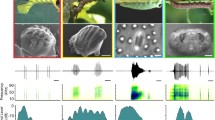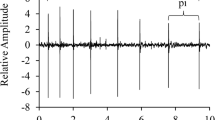Abstract
Caterpillars have many natural enemies and, therefore, have evolved a diversity of antipredator strategies. Most research focuses on those strategies (crypsis, countershading, and warning coloration) targeting visually guided predators. In contrast, defensive sounds, although documented for more than a century, have been poorly studied. We report on a novel form of sound production—chirping—in caterpillars of the common European Great Peacock moth (Saturnia pyri). Chirps are broadband, with dominant peaks ranging between the sonic (3.7 kHz) and ultrasonic (55.1 kHz) and are generated by a rapid succession of mandibular “tooth strikes.” Chirp trains are induced by simulated predator attacks and precede or accompany the secretion of a defensive chemical from integumental bristles, supporting our hypothesis that these sounds function in acoustic aposematism. We propose that these caterpillars generate multimodal warning signals (visual, chemical, and acoustic) to target the dominant sensory modalities of different predators, including birds, bats, and invertebrates.



Similar content being viewed by others
References
Bethune CJS (1868) A musical larva. Can Entomol 1:41
Bowen JL, Mahony SJ, Mason AC, Yack JE (2008) Vibration-mediated territoriality in the warty birch caterpillar Drepana bilineata. Physiol Entomol 33:238–250
Bowers MD (2003) Hostplant suitability and defensive chemistry of the Catalpa sphinx, Ceratomia catalpae. J Chem Ecol 29:2359–2367
Brown SG, Boettner GH, Yack JE (2007) Clicking caterpillars: acoustic aposematism in Antheraea polyphemus and other Bombycoidea. J Exp Biol 210:993–1005
Castellanos I, Barbosa P (2006) Evaluation of predation risk by a caterpillar using substrate-borne vibrations. Anim Behav 72:461–469
Deml R (2001) Influence of food and larval age on the defensive chemistry of Saturnia pyri. Z Naturforsch 56:89–94
Deml R, Dettner K (1993) Biogenic amines and phenolics characterize the defensive secretion of saturniid caterpillars (Lepidoptera: Saturniidae): a comparative study. J Comp Physiol B 163:123–132
Deml R, Dettner K (1995) Effects of emperor moth larval secretions, hemolymph, and components on microorganisms and predators. Entomol Exp Appl 76:287–293
DeVries PJ (1991) Call production by myrmecophilous riodinid and lycaenid butterfly caterpillars (Lepidoptera): morphological, acoustical, functional, and evolutionary patterns. Am Mus Novitates 3025:1–23
Dooling RJ (1991) Hearing in birds. In: Webster D, Fay R, Popper A (eds) The evolutionary biology of hearing. Springer-Verlag, New York, pp 545–560
Ewing AW (1989) Arthropod bioacoustics; neurobiology and Behavior. Cornell University Press, New York
Fletcher LE, Yack JE, Fitzgerald TD, Hoy RR (2006) Vibrational communication in the cherry leaf roller caterpillar Caloptilia serotinella (Gracillarioidea Gracillariidae). J Insect Behav 19:1–18
Grant JB (2006) Diversification of gut morphology in caterpillars is associated with defensive behavior. J Exp Biol 209:3018–3024
Heinrich B (1979) Foraging strategies of caterpillars: leaf damage and possible predator avoidance strategies. Oecologia 42:325–337
Hristov N, Conner WE (2005) Sound strategy: acoustic aposematism in the bat-tiger moth arms race. Naturwissenschaften 92:164–169
Kalka M, Kalko EKV (2006) Gleaning bats as underestimated predators of herbivorous insects: diet of Micronycteris microtis (Phyllostomidae) in Panama. J Trop Ecol 22:1–10
Kirchner WH (1997) Acoustical communication in social insects. In: Lehrer M (ed) Orientation and communication in arthropods. Birkhauser Verlag, Basel Switzerland, pp 273–300
Kirchner WH, Röschard J (1999) Hissing in bumblebees: an interspecific defence signal. Insectes Soc 46:239–243
Lederhouse RC (1990) Avoiding the hunt: primary defenses of lepidopteran caterpillars. In: Evans DL, Schmidt JO (eds) Insect defenses. Adaptive mechanisms and strategies of prey and predators. State University of New York Press, Albany, pp 175–189
Masters WM (1979) Insect disturbance stridulation: its defensive role. Behav Ecol Sociobiol 5:187–200
Masters WM (1980) Insect disturbance stridulation: characterization of airborne and vibrational components of the sound. J Comp Physiol A 135:259–268
Meyhöfer R, Casas J, Dorn S (1997) Vibration-mediated interactions in a host-parasitoid system. Proc R Soc Lond B 264:261–266
Minet J, Surlykke A (2003) Auditory and sound producing organs. In: Kristensen NP (ed) Handbook of Zoology, vol IV. Arthropoda: Insecta. Lepidoptera, Moths and Butterflies, vol 2. WG de Gruyter, New York, pp 289–323
Ratcliffe JM, Nydam ML (2008) Multimodal warning signals for a multiple predator world. Nature 455:96–99
Reed EB (1868) A musical larva. Can Entomol 1:40
Regier JC, Cook CP, Mitter C, Hussey A (2008) A phylogenetic study of the 'bombycoid complex' (Lepidoptera) using five protein-coding nuclear genes, with comments on the problem of macrolepidopteran phylogeny. Syst Entomol 33:175–189
Rougeot P-C (1971) Les bombycoïdes (Lepidoptera–Bombycoïdea) de l’Europe et du Bassin Méditerranéen. Masson et Compagnie Éditeurs, Paris France
Rowe C, Guilford T (1999) The evolution of multimodal warning displays. Evol Ecol 13:655–671
Schwartzkopff J (1955) On the hearing of birds. Auk 72:340–347
Scoble MJ (1995) The Lepidoptera. Form function and diversity. Oxford University Press, New York
Travassos MA, Pierce NE (2000) Acoustics, context and function of vibrational signaling in a lycaenid butterfly-ant mutualism. Anim Behav 60:13–26
Wilson JM, Barclay RMR (2006) Consumption of caterpillars by bats during an outbreak of western spruce budworm. Am Midl Nat 155:244–249
Yack JE (2004) The structure and function of auditory chordotonal organs in insects. Microsc Res Techniq 63:315–337
Yack JE, Smith ML, Weatherhead PJ (2001) Caterpillar talk: acoustically mediated territoriality in larval Lepidoptera. P Natl Acad Sci USA 98:11371–11375
Acknowledgements
We thank B. Wenczel and R. Schafroth for supplying S. pyri, T. Eberhard for technical assistance, and two anonymous reviewers for helpful suggestions to the manuscript. We gratefully acknowledge research funding by the Natural Sciences and Engineering Research Council of Canada (JEY), the Canadian Foundation for Innovation, and Ontario Innovation Trust (JEY).
Author information
Authors and Affiliations
Corresponding author
Electronic Supplementary Materials
Below is the link to the electronic supplementary material.
A S. pyri larva is attacked near the head capsule region with blunt forceps (simulating an attack by an avian predator). The caterpillar responds primarily by stridulating an]d releasing chemicals from the scoli (not observable in the video). (MOV 994 kb)
A S. pyri larva is attacked near the posterior body region with blunt forceps (simulating an attack by an avian predator). The caterpillar responds by stridulating, releasing chemicals (not observable in the video) and thrashing its body toward the site of the attack. (MOV 1.13 mb)
Close-up movements of the mandibles during two chirp trains. During the first chirp train, each of the three chirps is associated with the right mandible sliding against the inner surface of the left mandible. During the second chirp train, the animal switches sides so that the left mandible slides against the inner surface of the right. (MOV 3.66 mb)
Rights and permissions
About this article
Cite this article
Bura, V.L., Fleming, A.J. & Yack, J.E. What’s the buzz? Ultrasonic and sonic warning signals in caterpillars of the great peacock moth (Saturnia pyri). Naturwissenschaften 96, 713–718 (2009). https://doi.org/10.1007/s00114-009-0527-8
Received:
Revised:
Accepted:
Published:
Issue Date:
DOI: https://doi.org/10.1007/s00114-009-0527-8




